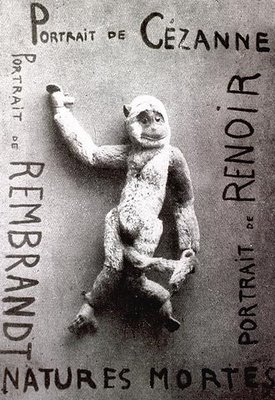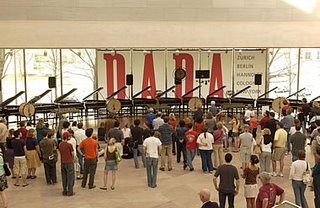 Ionarts was at a special event at the National Gallery of Art last night, a seminar for educators on the Dada exhibit that is in Washington right now (it came from the Centre Pompidou in Paris and will make one more stop, at the Museum of Modern Art in New York in June). I have been remiss about reviewing this exhibit, which I have been meaning to see. I didn't have enough time in the show last night to write about it yet, but I got a good head start for my official visit.
Ionarts was at a special event at the National Gallery of Art last night, a seminar for educators on the Dada exhibit that is in Washington right now (it came from the Centre Pompidou in Paris and will make one more stop, at the Museum of Modern Art in New York in June). I have been remiss about reviewing this exhibit, which I have been meaning to see. I didn't have enough time in the show last night to write about it yet, but I got a good head start for my official visit.The high point of the evening was a musical performance on the East Building Mezzanine. From March 12 through today, there were daily performances of an excerpt from one of the great musical compositions of the Dada period, George Antheil's noise composition for Fernand Léger's film Le Ballet mécanique (1924). Probably to the detriment of the sanity of the employees who work in the East Building, these regular performances have been extended through the end of the exhibit, on May 14 (Monday to Friday, 1 and 4 pm; Saturday and Sunday, 1 pm). If you are in Washington in the next month and a half, don't miss this opportunity.
 Antheil wanted to capture the music of machines -- according to him, not as a tribute but as a warning to audiences about how machines were invading their lives -- and envisioned a performance with 16 players pianos coordinated with two live pianists, airplane propellors, percussion, sirens, and bells. Antheil was not able to make that original plan work, and this version in a sense actually accomplishes what Antheil wanted to do: a fully automated performance. National Gallery music director Stephen Ackert pushed a button, and ten minutes of whirring, wild cacophony ensued. Fans pointing up to the ceiling play the airplane propellor parts. The computer link-up and installation are the work of Paul D. Lehrman of Tufts University and Eric Singer of the League of Electronic Musical Urban Robots (LEMUR). (You must click on that link: you know you want to.)
Antheil wanted to capture the music of machines -- according to him, not as a tribute but as a warning to audiences about how machines were invading their lives -- and envisioned a performance with 16 players pianos coordinated with two live pianists, airplane propellors, percussion, sirens, and bells. Antheil was not able to make that original plan work, and this version in a sense actually accomplishes what Antheil wanted to do: a fully automated performance. National Gallery music director Stephen Ackert pushed a button, and ten minutes of whirring, wild cacophony ensued. Fans pointing up to the ceiling play the airplane propellor parts. The computer link-up and installation are the work of Paul D. Lehrman of Tufts University and Eric Singer of the League of Electronic Musical Urban Robots (LEMUR). (You must click on that link: you know you want to.)Robert Gable, Articles on George Antheil (aworks, March 2005) Charles T. Downey, Michael Nyman, Man and Boy: Dada (August 9, 2004) Charles T. Downey, George Antheil, Piano Sonatas, Guy Livingston (May 26, 2004) Robert R. Reilly, Bad Boy Made Good: George Antheil (Crisis, February 2002) |
Although Antheil's noisy dance is a hard act to follow, Stephen Ackert took to one of the pianos, to accompany soprano Rosa Lamoreaux in a short set of three songs. Collage artist Kurt Schwitters wrote the poems for a 1928 Dada event in Hanover, Germany, called Das Zinnoberfest. Walther Lehnhoff and Walter Gieseking -- yes, that Walter Gieseking -- wrote the music. These songs were charmingly sung, complete with Ms. Lamoreaux's Charleston steps and application of various mallets to the nearby percussion instruments. Stylistically, they are all run-of-the-mill cabaret songs. Schwitters' texts are appropriately nonsensical, about Onkel Wilhelm's beautiful neckties (Der Krawattenmacher), how the newest technology is so necessary for all ages of people (Ohne die Technik im Haushalt), and the greed of the world and a little grandmother hopping around in Canada (Der Zinnoberschlager). I am always happy to hear Ms. Lamoreaux, who regularly surprises me by pushing the boundaries of what I think of as her repertoire.
A reception of gustatory pleasures followed in the Cascade Cafe. You don't have to offer free food and wine to teachers more than once. Thanks to the National Gallery for a diverting and informative evening.
No comments:
Post a Comment